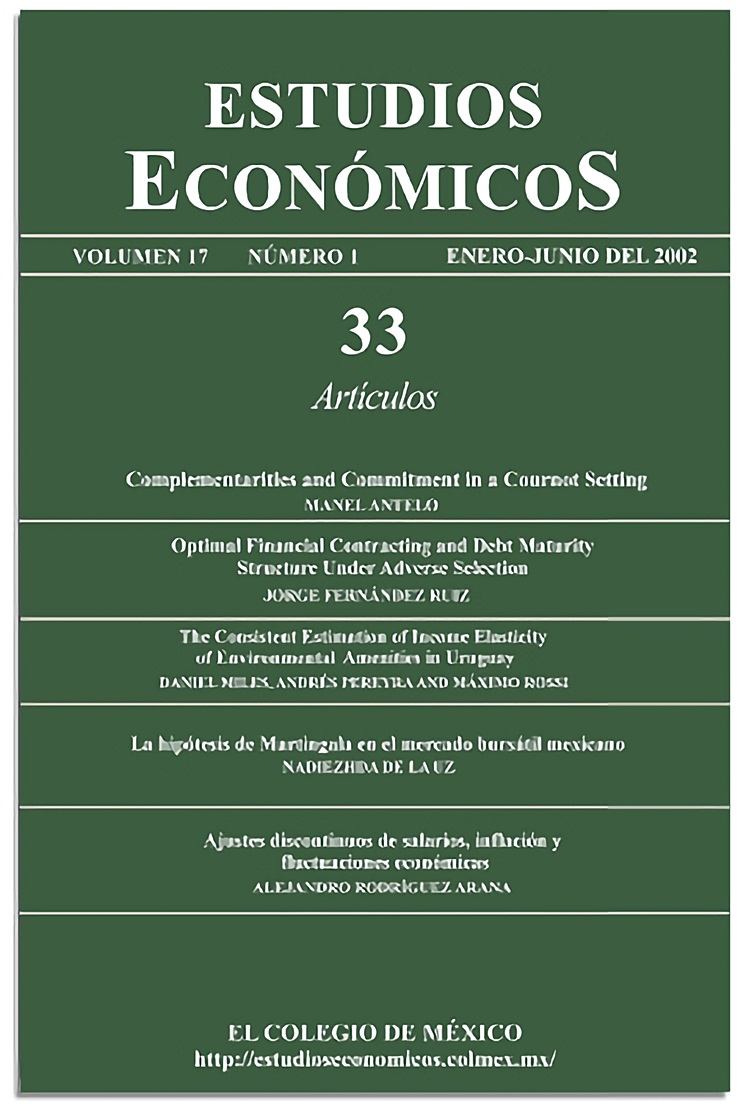Artículos
Publicado 2002-01-01
Palabras clave
- salario,
- inflación,
- curvas de Phillips
Cómo citar
Rodríguez Arana, A. (2002). Ajustes discontinuos de salarios, inflación y fluctuaciones económicas. Estudios Económicos De El Colegio De México, 17(1), 129–161. https://doi.org/10.24201/ee.v17i1.196
Resumen
Si los salarios nominales se ajustan menos frecuentemente que los precios, un crecimiento constante de la cantidad de dinero va a provocar fluctuaciones cíclicas de la producción y de la inflación. En algunas ocasiones, el mismo fenómeno puede modificar la producción promedio de largo plazo de la economía, generando curvas de Phillips que a veces tienen pendiente negativa y otras pendiente positiva.
Descargas
Los datos de descargas todavía no están disponibles.
Citas
- Akerlof, G. y J. Yellen (1985). “A near-rational model of the business cycle, with wage and Price inertia”, Quarterly Journal of Economics 100, (suplemento), pp. 823-838.
- Akerlof, G., W. Dickens y G. Perry (2000). “Near rational wage and price setting and the optimal rates of inflation and unemployment”, http://emlab.berkeley.edu.
- Banco de México (2001). Banco de datos, http://www.banxico.org.mx
- Bean, C. (1983). “Targeting Nominal Income: an Appraisal”, Economic Journal, 93, pp. 806-819.
- Blanchard, O. (1986). “The wage price spiral”, Quarterly Journal of Economics, 101, pp. 543-565.
- Blanchard, O. y S. Fisher (1989). Lectures on Macroeconomics, MIT Press, Mass.
- Bruno, M. y J. Sachs (1985). Economics of worldwide stagflation, Harvard University Press, Massachusetts.
- Caplin, A. y D. Spulber (1987). “Menu costs and the neutrality of money”, Quarterly Journal of Economics, 102, pp. 703-725.
- Caplin, A. y J. Leahy (1991). “State-dependent pricing and the dynamics of money and output”, Quarterly Journal of Economics, 106, pp. 683-708.
- Cuthberson, K., S. Hall y M. Taylor (1992). Applied econometric techniques, Harvester Wheatsheaf.
- Danziger, L. (1992). “On the prevalence of labor contracts with fixed duration”, American Economic Review, 22, pp. 195-206.
- Devereaux, M. (1989). “A positive theory of inflation and inflation variance”, Economic Inquiry, 27, pp. 105-116.
- Dornbusch, R. y M. Simonsen (1983). Inflation, debt and indexation, MIT Press, Massachusetts.
- Dornbusch, R. S. Fischer y R. Startz (2001). Macroeconomics, McGraw Hill.
- Fischer, S. (1977a). “Long term contracts, rational expectations and the optimal money supply rule”, en R. Lucas y T. Sargent (comps.) Rational expectations and econometric practice, vol. 1, 1981, University of Minessota Press, pp. 261-275.
- Fischer, S. (1977b). “Wage indexation and macroeconomic stability”, en K. Brunner y A. Meltzer (eds.), Stabilization of the domestic and international economy, Carnegie-Rochester conference series in public policy, vol. 5, North Holland.
- Friedman, M. (1969). The optimum quantity of money and other essays, Aldine, Chicago.
- Gonzaga, G. y J. C. Scandiuzzi (1998). “How does government wage policy affect wage bargaining in Brazil?”, http://www.econ.puc-rio.br.
- Gray, J. (1978). “On Indexation and contract lenght”, Journal of Political Economy, 86, pp. 1-18.
- Gray, J. (1976). “Wage Indexation: A macroeconomic approach”, Journal of Monetary Economics, 2, pp. 221-235.
- Jadresic, E. (1996). Wage indexation and macroeconomic stability: The Gray-Fischer theorem revisited, IMF WP 96/121.
- Layard, R., S. Nickell y R. Jackman (1992). Unemployment: Macroeconomic performance and the labour market, Oxford, Oxford University Press.
- Mankiw, N. G. (1985). “Small menu costs and large business cycle: A macroeconomic model of monopoly”, Quarterly Journal of Economics, 100, pp. 529-539.
- McDonald, I. y R. Solow (1981). “Wage bargaining and employment”, American Economic Review, 71, pp. 896-908.
- Meade, J. (1978). “The meaning of internal balance”, Economic Journal, 88, pp. 423-435.
- Poole, W. (1970). “Optimal choice of monetary policy instruments in a simple sthocastic macro model”, Quarterly Journal of Economics, 84, pp. 197-216.
- Romer, D. (1996). Advanced macroeconomics, McGraw Hill.
- Sheshinsky, E. y Y. Weiss (1983). “Optimum pricing policy under sthocastic inflation”, Review of Economic Studies, 50, pp. 513-529.
- Sheshinsky, E. y Y. Weiss (1977). “Inflation and costs of price adjustment”, Review of Economic Studies, 44, pp. 287-303.
- Simonsen, M. (1983). “Indexation: current theory and Brazilian experience”, en R. Dornbusch y M. Simonsen (eds.), Inflation, debt and indexation, MIT Press, Massachusetts.
- Taylor, J. (1980). “Aggregate dynamics and staggered contracts”, Journal of Political Economy, 1, pp. 1-23.
- Taylor, J. (1979a). “Staggered wage setting in a macro model”, American Economic Review, 69, pp. 108-113.
- Taylor, J. (1979b). “Estimation and control of a macroeconomic model with rational expectations”, Econometrica, 47, pp. 1267-1286.

